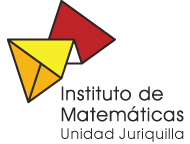A qualitative feedback theory for multiscale spatio-temporal behaviors
Ponente: Alessio Franci
Institución: Profesor Asociado de Biomatemáticas Facultad de Ciencias, UNAM
Tipo de Evento: Investigación
Life itself is insensitive to (most) quantitative details: how could it be robust if (all) details matter? Feedback theory and other qualitative mathematical theories, like singularity theory, can jointly be used to extract the key elements governing biological behaviors. This approach is particularly fruitful in the presence of multiple spatial and temporal scales: multiscale behaviors can be dissected into simpler feedback subsystems, each living in a characteristic scale, organized by a specific singularity, and exhibiting a specific behavior.
I will illustrate these ideas on the qualitative modeling of a biologically relevant class of spatio- temporal behaviors (multiscale traveling and standing waves), and their modulation. These behaviors can be studied in a three-scale feedback motif organized by the winged-cusp singularity. In the language of René Thom, this singularity is the organizing center for this class of behaviors. The importance of an organizing center is that it determines all the possible robust behaviors, as well as the necessary and sufficient number of parameters to (qualitatively) model those behaviors. It is exactly this property that allows to extract the key elements governing a given behavior, both in experiments and in mathematical modeling. I will briefly conclude with a couple of examples of successful application of the illustrated theory in the fields of neuro-modulation and bio-inspired engineering. Time permitting, I will run a live cognitive experiment to test a prediction of our theory.

Institución: Profesor Asociado de Biomatemáticas Facultad de Ciencias, UNAM
Tipo de Evento: Investigación
| Cuándo |
29/09/2016 de 12:00 a 13:00 |
|---|---|
| Dónde | Sala de seminarios 2 de Genómicas |
| Agregar evento al calendario |
|
Biology exhibits an enormous variety of spatial and temporal behaviors. We can easily recognize and name these behaviors because, beside quantitative differences, only qualitative properties matter. As an example, we can discern whether a neuron is “bursting” or not regardless the brain area, or even the animal, to which it belongs to, and regardless quantitative details of the recorded voltage trace. Many experimental questions are also qualitative in nature: will a molecule let a neuron burst? or will it silent it?
Life itself is insensitive to (most) quantitative details: how could it be robust if (all) details matter? Feedback theory and other qualitative mathematical theories, like singularity theory, can jointly be used to extract the key elements governing biological behaviors. This approach is particularly fruitful in the presence of multiple spatial and temporal scales: multiscale behaviors can be dissected into simpler feedback subsystems, each living in a characteristic scale, organized by a specific singularity, and exhibiting a specific behavior.
I will illustrate these ideas on the qualitative modeling of a biologically relevant class of spatio- temporal behaviors (multiscale traveling and standing waves), and their modulation. These behaviors can be studied in a three-scale feedback motif organized by the winged-cusp singularity. In the language of René Thom, this singularity is the organizing center for this class of behaviors. The importance of an organizing center is that it determines all the possible robust behaviors, as well as the necessary and sufficient number of parameters to (qualitatively) model those behaviors. It is exactly this property that allows to extract the key elements governing a given behavior, both in experiments and in mathematical modeling. I will briefly conclude with a couple of examples of successful application of the illustrated theory in the fields of neuro-modulation and bio-inspired engineering. Time permitting, I will run a live cognitive experiment to test a prediction of our theory.
Hosted by Marco Tulio Angulo, IM-UNAM, Juriquilla

